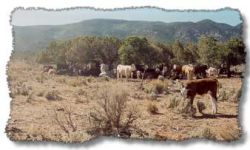

Grazing
The Cedar City Field Office authorizes livestock grazing on approximately 2,139,235 million acres of public lands. In total, the Cedar City Field Office manages 176 allotments, which are held by 173 different individuals or corporations. Livestock grazing allotments range in size from 40 acres to 126,000 acres. Grazing permittees purchase Animal Unit Months (AUMs) of livestock forage. An AUM is the amount of forage needed to sustain one cow and calf, five sheep, two burros, or one horse for one month. The majority of the allotments in the Cedar City Field Office are operating under a rotational grazing strategy which provides for plant recovery to enhance rangeland health. When rangelands are not meeting resource objectives, changes in grazing management are applied. Some small parcels of public land in the field office are reserved from grazing because of accessibility and/or to protect other resource values such as wildlife, riparian, recreation and water. The area is comprised of vegetation zones from salt desert shrub, sagebrush, pinion/juniper, to aspen-Douglas fir communities.
The Cedar City Field Office is focusing efforts in the range program to ensure that all grazing permits within the field office are fully processed by FY-09, as mandated by the U.S. Congress, which will ensure compliance with all applicable laws and regulations. Of the 173 permits we have, 40 have been fully processed under NEPA or are renewed as "active."
The Cedar City Field Office is committed to collecting monitoring data, and developing grazing management systems to ensure that administered public lands within our jurisdiction are being managed to guarantee the attainment of the Standards and Guidelines for Rangeland Health. By accomplishing these goals, the public can be assured that their public land is being managed effectively and efficiently.